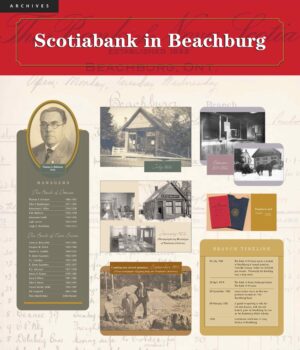The roots of the Bank of Nova Scotia in Beachburg, destined to be closed in June 2020, can be traced back to the time of George Bryson of Fort Coulonge in the 1800’s.
Bryson, an Ottawa Valley lumber pioneer from Coulonge, made his fortune in exporting white pine lumber. Although exported to Europe for use as masts and spars in fleets of ships, squared white timber destined for Britain was the main export product from the Ottawa River Valley
during the first half of the 19th century.
Money was not readily on hand to pay the employees during the peak lumbering years. The white pine commerce allowed Bryson, the biggest operator, to start printing his own currency due to insufficient British currency. It became known as the ‘Bryson Buck’. It was supported by other barons in the valley such as McLaren, Blackburn, Fraser and Gilmour all who became the original founding members along with Bryson when they established the Bank of Ottawa in 1873.
The head office was in Ottawa and branches in Pembroke, Cobden, Douglas, Westmeath and Beachburg in this area. The Beachburg branch was located where the current Pharmacy is now in Beachburg and remained there until relocating to a new building.
Like the other Canadian chartered banks, the Bank of Ottawa issued its own paper notes from 1874 to 1913 which circulated for some time afterwards. The bank expanded beyond the Ottawa area, and by 1918 had branches in six provinces. This initiated lumbering industries in the west as well.
During this era the supply of grains and cattle to the lumber industry was huge. It was the quality of the goods from the Ottawa Valley farmers, supplied locally and of such quality that their competitors from other parts of Ontario saw their sales half as profitable.
The lumber industry became successful primarily due to the rafts produced to a point of structural excellence. Then the rafts were able to be skillfully maneuvered with the cargos of square timbers from the forests of the interior down to Montreal and Quebec
City. Even though the lumber was exported from Quebec City, the trade helped Montreal become a commercial success during this era.
After World War I the Bank of Ottawa found it difficult to acquire new capital and meet the need for expansion to remain competitive. To achieve this the bank amalgamated with The Bank of Nova Scotia in 1919. Five shares of the Bank of Ottawa were equivalent to four shares of the Bank of Nova Scotia. Because of this ideal merger, the Bank of Nova Scotia were able to acquire new branches as far west as the Pacific Ocean.
Our Scotiabank in Beachburg has a storied history, unlike most others. It is an important part of local culture and for that one reason should be exemplified for its long survival from the 1800’s to where it is today – not simply considered a number to have its windows shuttered.
Reporter’s Note: This story was made possible with help from history buff Delbert O’Brien whose careers were fourfold; law, judging, agriculture and airlines. Visit the George Bryson Heritage House on Hwy 148, west of Coulonge museum – classified as a historic building.







![Kenopic/Smith Auction [Paid Ad]](https://whitewaternews.ca/wp-content/uploads/2018/10/advertising-100x75.jpeg)

